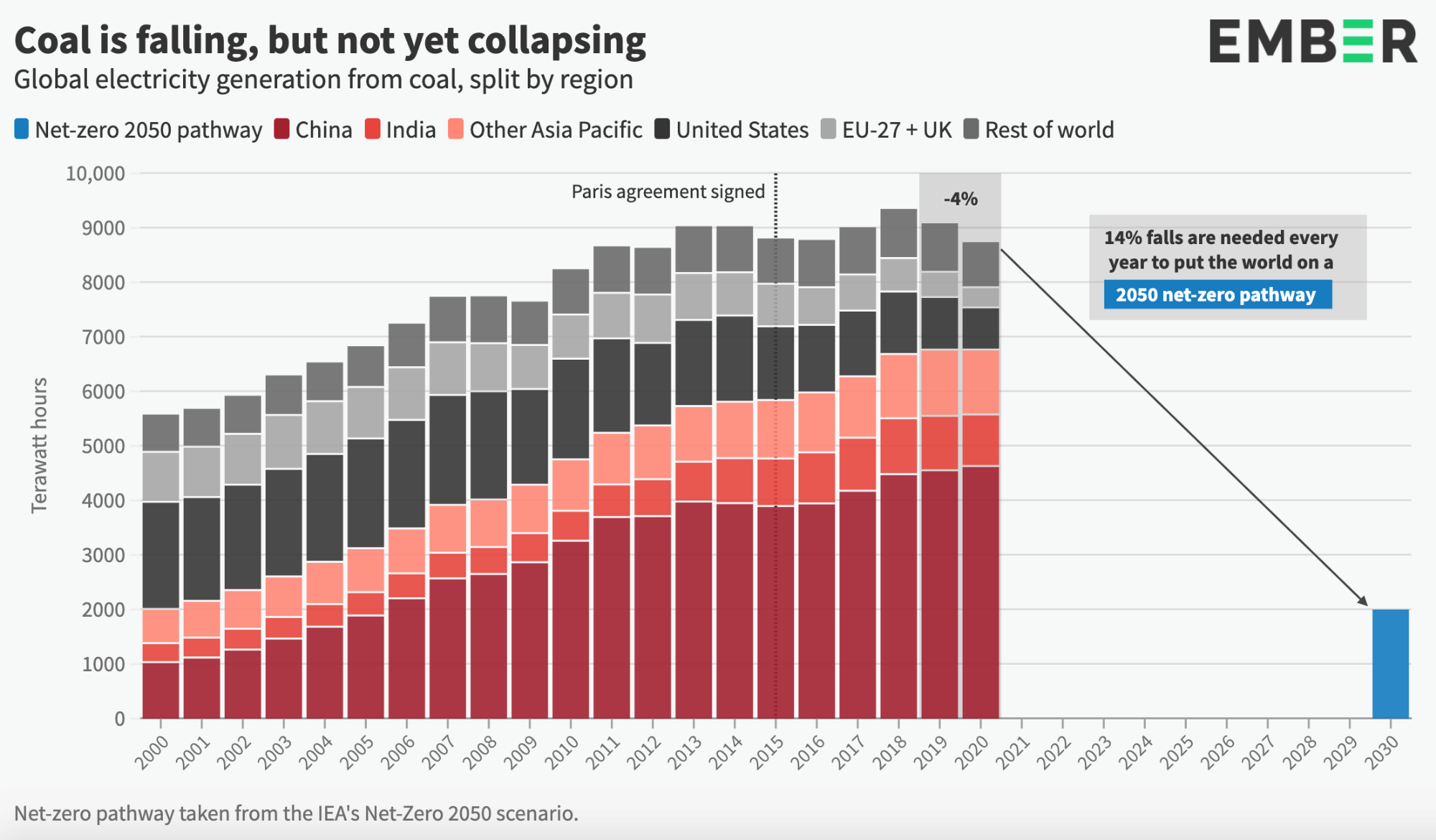Highlights
-0.1%
Global electricity demand fell slightly in 2020
+15%
Wind and solar generation rose by 15%
-4%
Coal fell a record 4%
About
This report showcases a global dataset for electricity generation & demand across 217 countries from 2000 to 2020. Data for 2020 covers 90% of the world’s electricity production.
Each year, we aim to be the earliest authoritative report to give insights into last year’s global electricity generation changes – offering an unbiased picture of the transition to fossil-free electricity.
Executive summary
Wind and solar drive a record fall in coal in 2020
But only because the pandemic paused rising electricity demand
Aditya Lolla Senior analyst, Ember
India has started its clean electricity transition. India now needs to ramp up wind and solar considerably in the next decade to both replace coal and meet rising electricity demand. India has the opportunity to ensure that coal generation doesn’t see a resurgence after the last two years of coal falling.
Global Trends
Wind and solar drive a record fall in coal in 2020
In this chapter:
G20 deep dives
Tracking the electricity transition in the world's major economies
In this chapter:
Download US report (English)
The US is responsible for half of the rise in global gas generation since 2015. Clean generation only partly made up for coal’s staggering fall since 2015.
Conclusion
Global electricity transition off track for 1.5C
The global electricity transition is on a crash course with climate targets.
Clean electricity is not yet being built quickly enough to keep pace with rising electricity demand. Wind and solar have provided the majority of the growth in clean electricity, with hydro and nuclear generation barely increasing. But even as wind and solar have risen to nearly a tenth of world electricity, their growth has slowed in recent years. This slow pace and lack of ambition is locking in reliance on fossil fuels.
2019 and 2020 bucked the trend as electricity demand temporarily slowed, which led to two record drops in coal generation. But even that wasn’t enough to put the world on target. Electricity demand will undoubtedly pick up again soon, especially as the world looks to electrify all the sectors still relying on fossil fuels.
We can’t let “mid-century net-zero targets” distract from the immediate need to focus on a quick transition out of burning coal for electricity.
Supporting Material
Methodology
Introduction
This annual report analyses electricity data from every country in the world to give the first accurate view of the global electricity transition in 2020. It aggregates generation data by fuel by country from 2000. 68 countries comprising 90% of world electricity generation have full-year data to 2020 and have formed the basis of an estimate for changes in worldwide generation. All remaining countries have full data as far as 2019. G20 countries, which comprise 84% of world electricity generation, each have a separate in-depth country analysis.
Definitions
Generation data is mapped into nine generation types. More information on mapping for different sources and countries can be viewed below. For the purpose of analysis these generation types are aggregated into different groupings as follows
For the purposes of this report, renewables are classified in line with the IPCC and include bioenergy. However, the climate impact of bioenergy is highly dependent on the feedstock, how it was sourced and what would have happened had the feedstock not been burnt for energy. The current EU bioenergy sustainability criteria do not sufficiently regulate out high-risk feedstocks and therefore electricity generation from bioenergy cannot be automatically assumed to deliver similar climate benefits to other renewables sources (such as wind and solar) over timescales relevant to meeting the commitments of the Paris Agreement. For more information please see Ember’s reports: The Burning Issue (June 2020) and Playing with Fire (December 2019).
Overview
Historical data
Data from the United States Energy Information Administration’s (EIA) international data browser forms the backbone of this report. With the exception of China, India, EU-27 and the United States, all data from 2000-2019 is taken from this source. For some generation types in non-OECD countries, 2019 data had not yet been published by the EIA. Where available, we used national data to estimate these values, otherwise, the average change for that generation type seen over 2015-2018 was added onto the 2018 generation value.
Thermal disaggregation
EIA international data does not disaggregate generation from fossil fuels. This was performed by Ember using two methods. If possible, the split between fossil fuels was estimated using the ratios of fossil generation types in BP’s statistical review of world energy. Fossil generation was disaggregated for any remaining countries by using the capacity split by fossil fuel type, taken from the WRI’s global power plant database.
2020 data
Data for 2020 is estimated using national sources. The year-on-year changes in generation for each fuel type from these sources are added onto the historical 2019 data to obtain a value for 2020. Data sources for Argentina, Canada, Ecuador, Kazakhstan and Russia provide no disaggregation of thermal generation – for these countries, estimates of the split between different generation types were made using the IEA’s monthly electricity generation statistics and BP’s statistical review of world energy.
World data
World data for 2000-2019 is the sum of all country data. World data for 2020 is estimated by summing generation for all countries where we have 2019 and 2020 data. Together this comprises 90% of global generation. The percentage changes in each fuel type from 2019 to 2020 are then applied to the world generation data for 2019, to create an estimate of global generation in 2020.
Acknowledgements
Report design by Designers for Climate
Thank you to all peer reviewers
- Roberto Kishinami, Energy Portfolio Coordinator at Institute for Climate and Society (iCS)
- Xunpeng Shi, President of the International Society for Energy Transition Studies
- A Prof. Peng Wang, Guangzhou Institute of Energy Conversion, Chinese Academy of Sciences
- A Prof. Kaveh Khalilpour, University of Technology Sydney (UTS)
- Philipp Litz, Project Manager, Agora Energiewende
- Garima Vats (TERI)
- Han Phoumin, Senior Energy Economist, Economic Research Institute for ASEAN and East Asia (ERIA)
- Fabby Tumiwa, Executive Director, Institute for Essential Services Reform (IESR)
- T.M. Indra Mahlia, Distinguished Professor, University of Technology Sydney (UTS)
- Michele Governatori, Ecco
- Jorge Villarreal Padilla, Director de Política Climática, Iniciativa Climática De México
- Rodrigo Palacios Saldaña, Investigador asociado, Iniciativa Climática De México
- Sonja Risteska
- Reza FathollahZadeh Aghdam, Assistant Professor of Energy Economics, Sultan Qaboos University (SQU), Oman
- Jesse Burton, E3G / University of Cape Town
- Joojin Kim and Gahee Han, Solutions for Our Climate (SFOC).
- Bengisu Özenç, Director, SEFIA
- Christine Shearer, Global Energy Monitor






